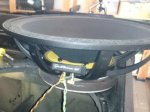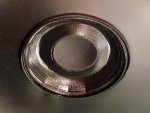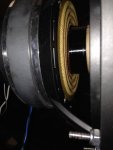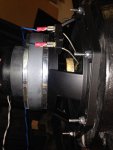Hi,
I've got a head scratcher here and could do with some useful opinions.
I've got some blown subs and want to know why and how they've blown and more importantly, how to prevent doing the same damage to them again.
Here's the scenario.
Arrive and set up for small theatre gig (100 people). Setup takes a couple of hours, so all the equipment is at room temperature by the time things are switched on.
The PA is switched on and tuned to the room. No problems there. It sounds so good that the LXeng comments on it sounding good.
It's not massively loud or bass heavy. OK, so the sub amp knobs are 3/4 of the way to max. There was more to give.
Then we hit the problem.
A mic cable is unplugged by one of the band, in order to repatch something. This cable is to a phantom powered mic.
You guessed it. BOOM!!!!!
No subs. Actually very distorted sounding subs, but unusable either way.
I've got them back to the workshop and am trying to work out what has happened.
From the attached pics, the damage looks thermal.
There's bubbling on the inside of the coil (highlighted in red).

Also, there are several vertical scratches around the outside of the coil that look like that's where they are in contact with the magnet (highlighted in red).
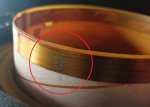

That's the distortion explained.
I've spoken to the manufacturer and I've given them the model numbers of the speakers and the spec of the amp involved and they have commented that the amp is a good match for the rating of the speakers. For the record, the subs are Peavey Hisys Subs (twin 15", 4ohm, 700w RMS) powered by a T.Amp Proline 2700 amp (1350w at 4ohm).
One thing I have noticed is the internal wiring of the speakers.

They appear to use 1mm cable. I use 2.5mm cable from the amp to the rear of the speaker.
From what I can see of the speaker wiring, the cabinet is wired in parallel. The yellow and blue cable goes to 1+ and 1- on the Speakon on the rear of the speaker and the red and black cable is connected to the + and - terminals of the first speaker in order to feed the second speaker.
Would the change from 2.5mm cable to 1mm cable result in a build up of heat in the smaller cable that is passed on to the speakers, causing the voice coils to expand and rub on the magnet?
Is that what caused the bubbling?
Is that something that can happen in a short BOOM event or is it something that takes longer to manifest itself?
Procedures can be revised with regards to patching with the PA on (i.e. death threats, etc), but is there anything else that can be done?
I know that this can be chalked up to experience, but what exactly have these subs experienced.
Any help would be appreciated, as this is something I am keen to not have repeat on me.
Thanks.
Karl.
I've got a head scratcher here and could do with some useful opinions.
I've got some blown subs and want to know why and how they've blown and more importantly, how to prevent doing the same damage to them again.
Here's the scenario.
Arrive and set up for small theatre gig (100 people). Setup takes a couple of hours, so all the equipment is at room temperature by the time things are switched on.
The PA is switched on and tuned to the room. No problems there. It sounds so good that the LXeng comments on it sounding good.
It's not massively loud or bass heavy. OK, so the sub amp knobs are 3/4 of the way to max. There was more to give.
Then we hit the problem.
A mic cable is unplugged by one of the band, in order to repatch something. This cable is to a phantom powered mic.
You guessed it. BOOM!!!!!
No subs. Actually very distorted sounding subs, but unusable either way.
I've got them back to the workshop and am trying to work out what has happened.
From the attached pics, the damage looks thermal.
There's bubbling on the inside of the coil (highlighted in red).

Also, there are several vertical scratches around the outside of the coil that look like that's where they are in contact with the magnet (highlighted in red).


That's the distortion explained.
I've spoken to the manufacturer and I've given them the model numbers of the speakers and the spec of the amp involved and they have commented that the amp is a good match for the rating of the speakers. For the record, the subs are Peavey Hisys Subs (twin 15", 4ohm, 700w RMS) powered by a T.Amp Proline 2700 amp (1350w at 4ohm).
One thing I have noticed is the internal wiring of the speakers.

They appear to use 1mm cable. I use 2.5mm cable from the amp to the rear of the speaker.
From what I can see of the speaker wiring, the cabinet is wired in parallel. The yellow and blue cable goes to 1+ and 1- on the Speakon on the rear of the speaker and the red and black cable is connected to the + and - terminals of the first speaker in order to feed the second speaker.
Would the change from 2.5mm cable to 1mm cable result in a build up of heat in the smaller cable that is passed on to the speakers, causing the voice coils to expand and rub on the magnet?
Is that what caused the bubbling?
Is that something that can happen in a short BOOM event or is it something that takes longer to manifest itself?
Procedures can be revised with regards to patching with the PA on (i.e. death threats, etc), but is there anything else that can be done?
I know that this can be chalked up to experience, but what exactly have these subs experienced.
Any help would be appreciated, as this is something I am keen to not have repeat on me.
Thanks.
Karl.


